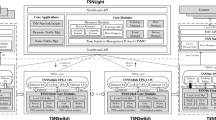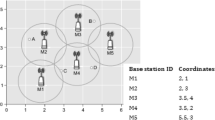Abstract
With the fast progresses of network technology, Video-On-Demand (VOD) service has found more and more applications. The transmission of multimedia files places heavy burdens on the Internet owing to their large sizes. To resolve this issue, caching servers are deployed at the edge of the Internet to meet most needs of local users by caching some popular videos. This paper provides an approach to choose the cached videos under the time-varying user behavior. Our approach estimates the average access intervals of a video with an Exponential Weighted Moving Average (EWMA) approach and furthermore predicts the video’s future popularity based on its historical access intervals. The forgetting and predicting operations enable the algorithm to not only track the change of the time-varying user accesses, but also reduce the effects of the randomness of a single user access on the caching performance. In addition, we propose a new segmentation approach, which makes the storage granularity independent from the management granularity and can make a better use of the cache space. Simulation results show that our segmentation approach has a higher Byte-Hit Ratio than uniform segmentation and chunk segmentation, and our caching algorithm outperforms Least Recently Used (LRU), Least Frequently Used (LFU) and EWMA.










Similar content being viewed by others
Notes
In reality, videos may not have the same length. Then we can first determine a reasonable segment size and partition videos with that given segment size. Of course, different videos may have different numbers of segments. Fortunately, all our approaches are still applicable because the concerned object in the caching procedure is segment, rather than video. Under that situation, m 1 denotes the number of segments of the longest video. In the discussion here and the later simulations, the benefit of the equal length assumption is that we can know the total number of segments is equal to the multiplication of m 1 and the total number of videos.
In that case, we repeat this random choice until a qualified r 2 is obtained.
References
Dyaberi JM (2011) Networking and storage support for video-on-demand data delivery. Purdue University, West Lafayette, Indiana
Yu H, Zheng D, Zhao BY, Zheng W (2006) Understanding user behavior in large-scale video-on-demand systems. In: EuroSys, pp 333–344
Yu J, Chou CT, Du X, Wang T (2006) Internal popularity of streaming video and its implication on caching. In: the 20th International Conference on Advanced Information Networking and Applications (AINA06)
Yu J , Chou CT, Yang Z, Du X, Wang T (2006) A dynamic caching algorithm based on internal popularity distribution of streaming media. Multimedia Systems 12(2):135–149
Hofmann M, Ng TE, Guo K, Paul S, Zhang H (1999) Caching techniques for streaming multimedia over the internet. Bell Laboratories Technical Report, pp BL011345–990409–04TM
Wu KL, Yu PS, Wolf JL (2001) Segment based proxy caching of multimedia streams.In:the 10th international conference on World Wide Web, pp 36–44
Wu KL, Yu PS, Wolf JL (2004) Segmentation of multimedia streams for proxy caching. IEEE Trans Multimed 6(5):770–780
Zhang X, Chen S, Shen B, Wee S (2003) Adaptive and lazy segmentation based proxy caching for streaming media delivery. In: The 13th international workshop on Network and Operating Systems Support for Digital Audio and Video, pp 22–31
Sen S, Rexford J, Towsley D (1999) Proxy prefix caching for multimedia streams. In: IEEE International Conference on Computer and Communications Societies(INFOCOM 99), pp 1310–1319
Park SH, Lim EJ, Chung KD (2001) Popularity-based partial caching for VOD systems using a proxy server. In: IEEE International Parallel and Distributed Processing Symposium (IPDPS 01), pp 11–119
Miao Z, Ortega A (1999) Proxy caching for efficient video services over the Internet. In: The 9th international packet video workshop
Liu J, Xu J (2004) Proxy caching for media streaming over the internet. IEEE Commun Mag 42(8):88–94
Chen S, Wang H, Zhang X, Shen B, Wee S (2005) Segment-based proxy caching for internet streaming media delivery. IEEE Trans Multimed 12(3):59–67
Miao Z, Ortega A (2002) Scalable proxy caching of video under storage constraints. IEEE J Sel Areas Commun 20(7):1315–1327
Kangasharju J, Hartanto F, Reisslein M, Ross KW (2002) Distributing layerd encoded video through caches. IEEE Trans Comput 51(6):622–636
Hartanto F, Kangasharju J, Reisslein M, Ross K (2006) Caching videos objects: layers vs versions. Multimedia Tools Appl 31(2):221–245
Brampton A, MacQuire A, Fry M, Rai IA, Race NJP, Mathy L (2009) Characterising and exploiting workloads of highly interactive video-on-demand. Multimedia Systems 15(1):3–17
Vakali A (2000) LRU-based algorithms for web cache replacement.In: International conference on electronic commerce and web technologies, pp 409–418
Sokolinsky LB (2004) LFU-K: An effective buffer management replacement algorithm. In: The 9th international conference on database systems for advanced applications, pp 670–681
Cherkasova L, Gupta M (2004) Analysis of enterprise media server workloads: access patterns, locality, content evolution and rates of change. IEEE/ACM Trans Networking 12(5):781–794
Guo L, Tan E, Chen S, Xiao Z, Zhang X (2007) Does internet media traffic really follow zipf-like distribution. In: SIGMETRICS07, pp 35–360
Chen T (2007) Obtaining the optimal cache document replacement policy for the caching system of an EC website. Eur J Oper Reserach 181(2):828–841
Robinson J, Edvarakonda M (1990) Data cache management using frequency-based replacement. In: Proceedings of the 1990 ACM SIGMETRICS on the measurement and modeling of computer systems, pp 132–14
Lau PY, Park S, Kim T (2010) Dynamic time-weighted popularity index:a video-on-demand case. In: IEEE international conference on network infrastructure and digital content, pp 809–814
Sheikh R, Kharbutli M (2010) Improving cache performance by combining cost-sensitivity and locality principles in cache replacement algorithms. In: IEEE international conference on computer design, pp 76–83
Cao P, Irani S (1997) Cost-aware www proxy caching algorithms. In: Proceedings of the USENIX symposium on internet technologies and systems
Nair T R G, Jayarekha P (2010) A rank based replacement policy for multimedia server cache using zipf-like law. J Comput 4(3):14–22
Li F, Li J, Hu Z, Zhou J (2009) Common caching replacement algorithm for video-on-demand system. In: 2009 international conference on web information systems and mining, pp 748–751
Shen L, Tu W, Steinbach E (2007) A flexible starting point based partial caching algorithm for vido on demand. In: IEEE international conference on multimedia and exop, pp 76–79
Muhammad M, Tu W, Steinbach E (2008) Evaluation of segment-based proxy caching for video on demand. In: IEEE international conference on multimedia and expo, pp 1093–1096
Tu W, Steinbach E, Muhammad M, Li X (2009) Proxy caching for video-on-demand using flexible starting point selection. IEEE Trans Multimedia 11(4):716–729
Reisslein M, Hartanto F, Ross K W (2002) Interactive video streaming with proxy servers. Infromation Sci Spec issue Interact virtual Environ Dist Educ 140(1-2):3–31
Elias B, Ioannis S (1999) Proxy caching and video segmentation based on request frequencies and access costs. In: IEEE 10th International Conference on Telecommunications, pp 1367–1372
Choi J, Reaz A, Mukherjee B (2012) A survey of user behavior in VoD service and bandwidth-saving multicast streaming schemes. IEEE Commun Surv Tutorials 14(1):156–169
Breslau L, Cao P, Fan L, Phillips G, Shenker S (1999) Web caching and zipf-like distributions: evidence and implications. In: IEEE eighteenth annual joint conference on computer and communications societies, pp 126–134
Abhari A, Soraya M (2010) Workload generation for youtube. Multimedia Tools Appl 46(1):91–118
Tang W, Fu Y, cherkasova L, Bahdat A (2003) Long-term streaming media server workload and analysis and modeling. HP Laboratories Palo Alto, Tech. Rep. HPL-2003-23
Wolf JL, Yu PS, Shachnai H (1997) Disk load balancing for video-on-demand systems. Multimedia Systems 5(6):358–370
Acknowledgments
This work was partially supported by National Natural Science Foundation of China under Grant 61273112, the fund from Young Innovation Promotion Association of CAS and 973 Program under Grant 2013CB733100.
Author information
Authors and Affiliations
Corresponding author
Rights and permissions
About this article
Cite this article
Ling, Q., Xu, L., Yan, J. et al. An adaptive caching algorithm suitable for time-varying user accesses in VOD systems. Multimed Tools Appl 74, 11117–11137 (2015). https://doi.org/10.1007/s11042-014-2220-y
Received:
Revised:
Accepted:
Published:
Issue Date:
DOI: https://doi.org/10.1007/s11042-014-2220-y




